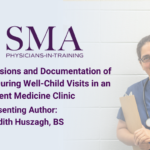Abstract | May 6, 2021
Improving Discussions and Documentation of E-cigarette Use During Well-Child Visits in an Adolescent Medicine Clinic
Learning Objectives
- Surveil for change in patient behaviors/culture and update their clinical workflows and tools to reflect these changes in their practice;
- Identify a gap in patient care and provide patient-informed tools that facilitate conversation through prompting of both the patient and provider.
Background:
Health professionals have an important role in screening for e-cigarette use, educating patients about risks, and encouraging cessation, yet many do not consistently discuss and document conversations about these topics with patients. Perspectives of adolescents and their providers on e-cigarette use were obtained and informed the implementation of two interventions to improve rates of patient-provider discussions and subsequent clinical documentation of e-cigarette use.
Methods:
An initial survey was completed by attending and resident physicians to understand knowledge and care gaps with regard to e-cigarette use. Patient surveys were conducted at the end of well-child visits to capture whether e-cigarette use was discussed during the visit, frequency of e-cigarette use, preferred terminology for referring to e-cigarettes, and which substances were commonly delivered. Two interventions were implemented to improve patient-provider discussions and clinical documentation of e-cigarette use during well-child visits. Baseline and post-intervention patient-provider discussion rates (per patient surveys) and corresponding clinical documentation rates (per EHR chart review) were compared.
Results:
Three key themes emerged from the initial provider survey: (1) providers desired educational materials (i.e. handouts, websites) to share with patients, (2) providers wanted to know the terminology used by adolescents to refer to e-cigarettes, and (3) optimal discussion and documentation of e-cigarette use occurs during the HEEADSS review and corresponding visit note documentation. Two interventions were developed to improve discussions and documentation of e-cigarette use: (1) an informational poster added to patient rooms, and (2) an expanded documentation note template that included a comprehensive multi-select substance list for the HEEADSS review.
Success of both discussion and documentation of e-cigarette use during well-child visits increased by 20.58% after both interventions were implemented. The rate of discussions increased by 9.32% after the addition of informational posters to patient rooms. The rate of documentation increased by 43.04% after the addition of an expanded documentation note template. Most frequently reported terms by patients for referring to e-cigarettes included “vape”, “JUUL”, and “ecig”. The term “dab pen” was also used in conjunction with use of marijuana or THC oil additives.
Conclusion:
An educational poster in patient rooms was most helpful for increasing discussions of e-cigarette use during well-child visits, and providing an expanded note template improved the thoroughness of discussion of substance use and related visit documentation. Lack of standardization across clinic providers resulted in inconsistencies in rates of discussion and documentation of e-cigarette use during well-child visits that was improved after the two interventions.

